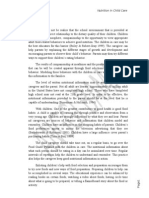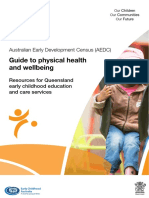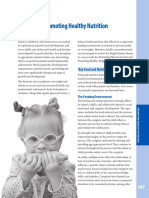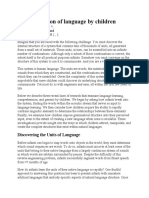Mind, Body, and Soul: Nutrition
Mind, Body, and Soul: Nutrition
Uploaded by
Loni SumruldCopyright:
Mind, Body, and Soul: Nutrition
Mind, Body, and Soul: Nutrition
Uploaded by
Loni SumruldCopyright
Share this document
Did you find this document useful?
Is this content inappropriate?
Copyright:
Mind, Body, and Soul: Nutrition
Mind, Body, and Soul: Nutrition
Uploaded by
Loni SumruldCopyright:
Mind, Body, & Soul
A Newsletter on Health, Safety, and Nutrition
LONI SUMRULD | ECE 105 | ISSUE NO. 3
following directions and problem-
solving and physical skills such as
Let’s Get Kids Cooking: fine motor development) that lend
themselves to creativity and
confidence in creating, tweaking,
Food. Everyone needs it. But how to ensure that the child is getting and eating their favorite healthy
much of it? And what kinds? If the proper amount of food, recipes. (The benefits of cooking with
adults have trouble figuring this macro- and micronutrients to be preschoolers, n.d.) Together, we can
out, how can we ensure that our healthy. It is not enough to simply give children the best chance for
children are getting the nutrition introduce new foods to children or success by laying the nutritional
they need? to tell them about what foods they building blocks of their future!
should or shouldn’t be eating, but
When a child is hungry, not only children eat what their caregivers
can they not focus and pay eat. If the adults in their lives
attention in school, but a lack of overeat, then children are also
f o o d a l s o s t u n t s t h e c h i l d ’s prone to this, which links parents’
cognitive and physical relationships with food to a
development. (Nutrition and early child’s. (Lindsay et al., 2006)
brain development, n.d.) Ensuring
that a child has proper nutrition School-aged children can often be
sets them up for success as a child, picky eaters, so involving them in
but also paves the way for the the cooking process is a method
habits that they will maintain into that helps break away from those
adulthood. preferences while also increasing
their knowledge about a variety of
Parents and caregivers are the first foods. These hands-on skills teach
people to introduce food into a children to be confident and gain
child’s life, it is their responsibility skills (cognitive skills such as
THE LACK OF ACCESS TO PROPER NUTRITION IS NOT ONLY FUELING OBESITY, IT IS
LEADING TO FOOD INSECURITY AND HUNGER AMONG OUR CHILDREN. - TOM VILSACK
How Did That Get in My
LunchBox?
How Did That Get In My Lunchbox?: The Story of Food by
Chris Butterworth takes children on an exciting food
journey. The book answers questions like who made the
bread for the sandwich? What about the cheese inside? Who
plucked the fruit? And where did the chocolate in that
cookie get its start?
This book teaches children to appreciate the long journey
that food must take to get onto their plates.
Cafeteria Tour
Next week, our class will be taking a tour of the school’s
cafeteria facility for a “behind the scenes” look at where the
food they eat at school comes from. The kitchen servers and
staff will talk about what they cook and how they prepare it
to ensure that all the students are getting the nutrition they
need to be healthy and to answer any food-based questions
that come their way.
For the interested children, the cafeteria is accepting
student helpers to prepare and serve snacks, and to help
serve other students when necessary at meals.
If your child has expressed interest in being a cafeteria
helper, a permission slip and waiver has been mailed to allow
them into the kitchen.
We’re growing a Garden!
This week we started our more about the
class garden! Each foods they eat.
student got to pick
a fruit or vegetable Ask your kids
to grow and about the seeds
planted the seeds that they chose
themselves. to plant and
w h y. C h a n c e s
Ha v i n g the are, they want to
students work tell you all about
together to care for this great or new
and maintain our garden is a food that they’re growing
great exercise that teaches and excited to try!
students responsibility and
allows children to learn
Take it Home With you
Books about Food:
How Does My Garden Grow? by Gerda Muller
A Fruit is a Suitcase for Seeds by Jean Richards
What If There Were No Bees? A Book about the Grassland
Ecosystem by Suzanne Slade
At-Home Activities:
Let your kids be the produce pickers. At the supermarket,
engage your children so that they are part of the shopping
process. Instead of putting them in the cart with your phone,
ask them about the foods that they see and ask their opinion
about at least one meal (or a fruit or vegetable). This keeps them
interested in what’s going on in the kitchen, and inevitably, what
goes into their bodies.
Become an urban harvester. Websites like Falling Fruit
For more information on health, safety, and contain a large list (in map form) of what plants are growing near
nutrition, visit my ECE Portfolio. you! They note each spot with a red dot on the map and tell you
what’s growing there and whether or not the source is on public
or private land to be picked. Get out with your kids for a
weekend excursion and try to find a good, healthy snack!
Volunteer in the garden!
Our garden may have just gotten started, but we’re anticipating a
large crop and need help maintaining the space. If you’re interested
or want to learn more about gardening and why your children are
doing it, please get in contact. We would love to dig around in the
dirt with you!
You might also like
- Notes For Healthy Kids - Rujuta DiwekarDocument171 pagesNotes For Healthy Kids - Rujuta Diwekarindu tiwari100% (6)
- Weaning Sense: A baby-led feeding guide from 4 months onwardsFrom EverandWeaning Sense: A baby-led feeding guide from 4 months onwardsNo ratings yet
- French Gender RulesDocument65 pagesFrench Gender RulesJwala Srinivas100% (2)
- CHCECE004 Promote and Provide Healthy Food and DrinksDocument15 pagesCHCECE004 Promote and Provide Healthy Food and DrinksOkwfNo ratings yet
- The Clean-Eating Kid: Grocery Store Food Swaps for an Anti-Inflammatory DietFrom EverandThe Clean-Eating Kid: Grocery Store Food Swaps for an Anti-Inflammatory DietNo ratings yet
- Brochure Original22Document2 pagesBrochure Original22api-505913940No ratings yet
- AOTA Handout - Establishing Mealtime Routines For ChildrenDocument2 pagesAOTA Handout - Establishing Mealtime Routines For ChildrenAble BatangasNo ratings yet
- Manuscript Chapter 1 3Document17 pagesManuscript Chapter 1 3Aprilyn Galvizo MorandanteNo ratings yet
- Kesehatan Gizi Selection 2Document10 pagesKesehatan Gizi Selection 2randykurniawan19No ratings yet
- Food and Nutrition: What Nourishes Our Children?Document9 pagesFood and Nutrition: What Nourishes Our Children?Dorin Frunza100% (1)
- Food and NutritionDocument24 pagesFood and NutritionDeepanarendraNo ratings yet
- Buku Informasi Kandungan Gizi PJASDocument6 pagesBuku Informasi Kandungan Gizi PJASRelinda PriharumNo ratings yet
- Sample Essay - Question 2 - Positive Attidude - B5 - BRAINSTORMINGDocument4 pagesSample Essay - Question 2 - Positive Attidude - B5 - BRAINSTORMINGkaybeeNo ratings yet
- The American Dietetic Association Guide to Healthy Eating for Kids: How Your Children Can Eat Smart from Five to TwelveFrom EverandThe American Dietetic Association Guide to Healthy Eating for Kids: How Your Children Can Eat Smart from Five to TwelveNo ratings yet
- Mini Healthy Habits for Happy Kids: Discover The Surprising Secrets Of Healthy Eating For The Successful And Healthy Life Of Your ChildFrom EverandMini Healthy Habits for Happy Kids: Discover The Surprising Secrets Of Healthy Eating For The Successful And Healthy Life Of Your ChildNo ratings yet
- Team ZaletaDocument35 pagesTeam ZaletaAnsley San Juan DelvalleNo ratings yet
- Adventures in Homeschooling: Adventures in Homeschooling Book #1, #5From EverandAdventures in Homeschooling: Adventures in Homeschooling Book #1, #5No ratings yet
- Circular_1714718617f8aaDocument10 pagesCircular_1714718617f8aapattanikpoonamNo ratings yet
- AEDC Guide To Physical Health and WellbeingDocument6 pagesAEDC Guide To Physical Health and WellbeingKedar SilwalNo ratings yet
- Signature Assignment First DraftDocument8 pagesSignature Assignment First Draftapi-376760226No ratings yet
- Nurturing with Nutrition: Everything You Need to Know About Feeding Infants and ToddlersFrom EverandNurturing with Nutrition: Everything You Need to Know About Feeding Infants and ToddlersNo ratings yet
- Question 1Document6 pagesQuestion 1katlegobasetsana01No ratings yet
- Final-Food CirriculumDocument6 pagesFinal-Food Cirriculumapi-555343739No ratings yet
- Exploring Baby-Led Feeding: A Stress-Free Approach to Introducing Solids.From EverandExploring Baby-Led Feeding: A Stress-Free Approach to Introducing Solids.No ratings yet
- From Picky to Powerful: The Mindset, Strategies, and Know-How You Need to Empower Your Picky EaterFrom EverandFrom Picky to Powerful: The Mindset, Strategies, and Know-How You Need to Empower Your Picky EaterNo ratings yet
- KEiC Picky Eater GuideDocument14 pagesKEiC Picky Eater GuideAni Caballero PediatraNo ratings yet
- Chapter 1 - 3Document10 pagesChapter 1 - 3Ris Lloyd TabayNo ratings yet
- Designing A Community Based Nutrition Program Using The Hearth Model and The Positive Deviance Approach A Field Guide 1 PDFDocument85 pagesDesigning A Community Based Nutrition Program Using The Hearth Model and The Positive Deviance Approach A Field Guide 1 PDFRudo ZimunhuNo ratings yet
- Fussy Eating Strategies To Support Healthy Eating Behaviours ChildrenDocument3 pagesFussy Eating Strategies To Support Healthy Eating Behaviours ChildrenkimNo ratings yet
- DR Tastebud Template 11-19-19 Ashley and MeganDocument3 pagesDR Tastebud Template 11-19-19 Ashley and Meganapi-267192675No ratings yet
- Ped Basics Feeding Gerber 110 Fall 2002Document27 pagesPed Basics Feeding Gerber 110 Fall 2002Talavera Clau100% (1)
- Ethical Dilemmas: Feeding Children in Early Care and Learning SettingsDocument3 pagesEthical Dilemmas: Feeding Children in Early Care and Learning SettingsMishael AbogadoNo ratings yet
- Teach Children About Nutrition: The Most Common Nutrition Myths and Real Nutritional Needs for Children: The Master Parenting Series, #10From EverandTeach Children About Nutrition: The Most Common Nutrition Myths and Real Nutritional Needs for Children: The Master Parenting Series, #10No ratings yet
- Current Research in Nutrition and Food ScienceDocument8 pagesCurrent Research in Nutrition and Food Sciencenewbire vlogNo ratings yet
- A Healthy Baby's Diet and Care: Feeding and Traditional Care for Your Baby During The First Year of Its LifeFrom EverandA Healthy Baby's Diet and Care: Feeding and Traditional Care for Your Baby During The First Year of Its LifeNo ratings yet
- Lesson Plan COTDocument5 pagesLesson Plan COTMaricis Love OrdoyoNo ratings yet
- Inervention ReflectionDocument3 pagesInervention Reflectionapi-384481487No ratings yet
- Cooking Together: Nurturing Connections with Your Child on the SpectrumFrom EverandCooking Together: Nurturing Connections with Your Child on the SpectrumNo ratings yet
- Intuitive Eating FinalDocument3 pagesIntuitive Eating Finalapi-741797839No ratings yet
- Stories of Extreme Picky Eating: Children with Severe Food Aversions and the Solutions that Helped ThemFrom EverandStories of Extreme Picky Eating: Children with Severe Food Aversions and the Solutions that Helped ThemNo ratings yet
- Doblon Algrace Beed3c LP HealthDocument5 pagesDoblon Algrace Beed3c LP HealthDoblon AliNo ratings yet
- MATERNAL AND CHILD HEALTH NURSING SUMMARY Chapter 30-34 (Adelle Pillitteri)Document134 pagesMATERNAL AND CHILD HEALTH NURSING SUMMARY Chapter 30-34 (Adelle Pillitteri)CHRISTIE MONTANO100% (6)
- Rethinking Nutrition: Connecting Science and Practice in Early Childhood SettingsFrom EverandRethinking Nutrition: Connecting Science and Practice in Early Childhood SettingsNo ratings yet
- Eating Right from 8 to 18: Nutrition Solutions for ParentsFrom EverandEating Right from 8 to 18: Nutrition Solutions for ParentsNo ratings yet
- What to Feed Your Baby and Toddler: A Month-by-Month Guide to Support Your Child's Health and DevelopmentFrom EverandWhat to Feed Your Baby and Toddler: A Month-by-Month Guide to Support Your Child's Health and DevelopmentNo ratings yet
- Educational IssuesDocument2 pagesEducational Issuesapi-532693584No ratings yet
- Health Education Resource PacketDocument10 pagesHealth Education Resource Packetapi-708268519No ratings yet
- Promoting Healthy NutritionDocument26 pagesPromoting Healthy NutritionJose Fernando Díez Concha100% (1)
- Raising Anti-Diet Kids: A Parent's Actionable Guide to Ditch Diets and Cultivate Body RespectFrom EverandRaising Anti-Diet Kids: A Parent's Actionable Guide to Ditch Diets and Cultivate Body RespectNo ratings yet
- Writing Sample 1Document9 pagesWriting Sample 1api-744647418No ratings yet
- The Smart Mom's Guide to Healthy Snacking: The Smart Mom's GuideFrom EverandThe Smart Mom's Guide to Healthy Snacking: The Smart Mom's GuideNo ratings yet
- Pof Draft 2Document7 pagesPof Draft 2api-589325676No ratings yet
- How to Raise an Intuitive Eater: Raising the Next Generation with Food and Body ConfidenceFrom EverandHow to Raise an Intuitive Eater: Raising the Next Generation with Food and Body ConfidenceRating: 4 out of 5 stars4/5 (2)
- Cel VisualguideDocument27 pagesCel Visualguideapi-277123092No ratings yet
- Rule a Healthy Roost: Nutrition, Recipes, and Activities for Modern FamiliesFrom EverandRule a Healthy Roost: Nutrition, Recipes, and Activities for Modern FamiliesNo ratings yet
- HKK March 2011Document2 pagesHKK March 2011elfkinbabyNo ratings yet
- Final Draft 3Document16 pagesFinal Draft 3api-609537359No ratings yet
- Q1 W1 MtbmleDocument10 pagesQ1 W1 MtbmleMaria Cristina AguantaNo ratings yet
- BurnoutDocument309 pagesBurnoutAbhi JatNo ratings yet
- Physics - Centripetal Force Lab ReportDocument6 pagesPhysics - Centripetal Force Lab Reporttonytono100% (2)
- Meaning Shift Analysis of Indonesian Translated Noun Phrases in The Gabriel Garcia Marquez's Novel "Memories of My Melancholy Whores" Translated by Dian Vita EllyatiDocument16 pagesMeaning Shift Analysis of Indonesian Translated Noun Phrases in The Gabriel Garcia Marquez's Novel "Memories of My Melancholy Whores" Translated by Dian Vita EllyatiPuguh D SiswoyoNo ratings yet
- Spotify Case Study PaperDocument14 pagesSpotify Case Study Paperapi-507098917No ratings yet
- Dreams - The Language of The Higher SelfDocument28 pagesDreams - The Language of The Higher SelfMaheshNo ratings yet
- Spine Care FinalDocument220 pagesSpine Care FinalmansiagrawalNo ratings yet
- Pci To Cto - Copy SssDocument238 pagesPci To Cto - Copy SssSohil3100% (1)
- Stability of Structures: Additional TopicsDocument12 pagesStability of Structures: Additional Topicsmiry89100% (2)
- Rebound Hammer TestDocument8 pagesRebound Hammer TestEvello MercanoNo ratings yet
- The Acquisition of Language by ChildrenDocument18 pagesThe Acquisition of Language by Childrenariey_kiutNo ratings yet
- Kabaddi - WikipediaDocument36 pagesKabaddi - WikipediaSourav ShuklaNo ratings yet
- Venus ParadoxDocument23 pagesVenus ParadoxRobert StrangNo ratings yet
- Six Tastes of AyurvedaDocument2 pagesSix Tastes of AyurvedaVenkatesan Kalaivanan100% (2)
- Statistical Methods for Engineers 3rd edition G. Geoffrey Vining download pdfDocument81 pagesStatistical Methods for Engineers 3rd edition G. Geoffrey Vining download pdfgraulmunrok7100% (1)
- Moving Forward - UNHCR Malta MagazineDocument72 pagesMoving Forward - UNHCR Malta MagazineUNHCR Malta100% (1)
- LG4e TB3 MidtermDocument5 pagesLG4e TB3 MidtermSergey UryasevNo ratings yet
- MPU2222 Entrepreneurship I - Caug2017 (Bookmark) PDFDocument170 pagesMPU2222 Entrepreneurship I - Caug2017 (Bookmark) PDF黄珮珊100% (2)
- CH 5Document125 pagesCH 5omar_mahdyNo ratings yet
- Proposal For Sci Month CelebrationDocument3 pagesProposal For Sci Month CelebrationManuel Paulo AcogidoNo ratings yet
- Release The Blessing in Your Life 1Document6 pagesRelease The Blessing in Your Life 1Mave Capuchino100% (1)
- English Prose AnalysisDocument226 pagesEnglish Prose AnalysisSiska LorenzaNo ratings yet
- Hesi Gerontology Age-Related Risks PDFDocument14 pagesHesi Gerontology Age-Related Risks PDFAna BienneNo ratings yet
- Activities Week 13-17 - DOBLONDocument2 pagesActivities Week 13-17 - DOBLONAl Grace DoblonNo ratings yet
- Metatron Initiations PDFDocument6 pagesMetatron Initiations PDFjacknewman870100% (6)
- Effects of Store Fixture Shape at Retail CheckoutDocument8 pagesEffects of Store Fixture Shape at Retail Checkoutsiddev12344321No ratings yet
- Differential EquationsDocument146 pagesDifferential Equationsbxlmichael8837No ratings yet
- By WRITINGKOREA Staff: Writingkorea Root List Root Word Meanings Origin Examples and DefinitionsDocument29 pagesBy WRITINGKOREA Staff: Writingkorea Root List Root Word Meanings Origin Examples and DefinitionsRoger W ShimNo ratings yet

























































































